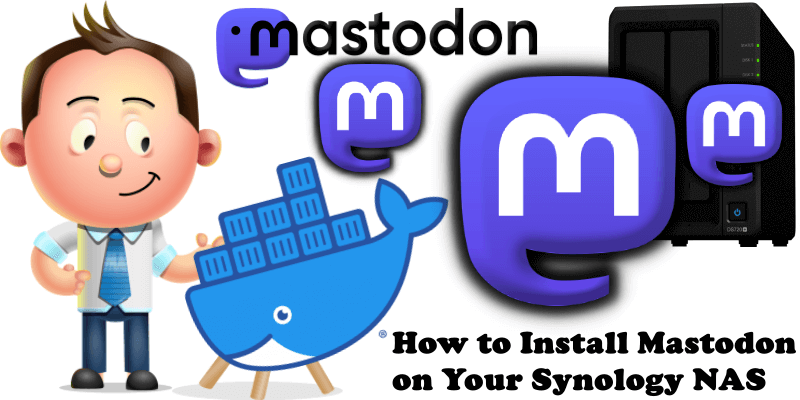
Mastodon is a free, open-source social network server based on ActivityPub where users can follow friends and discover new ones. On Mastodon, users can publish anything they want: links, pictures, text, video. All Mastodon servers are interoperable as a federated network (users on one server can seamlessly communicate with users from another one, including non-Mastodon software that implements ActivityPub like Pixelfed and WriteFreely). In this step by step guide I will show you how to install Mastodon on your Synology NAS using Docker and Portainer.
This guide works perfectly with the latest Mastodon v4.4.1 release.
STEP 1
Please Support My work by Making a Donation.
STEP 2
Install Portainer using my step by step guide. If you already have Portainer installed on your Synology NAS, skip this STEP. Attention: Make sure you have installed the latest Portainer version.
STEP 3
Make sure you have a synology.me Wildcard Certificate. Follow my guide to get a Wildcard Certificate. If you already have a synology.me Wildcard certificate, skip this STEP.
STEP 4
Go to Control Panel / Login Portal / Advanced Tab / click Reverse Proxy. Follow the instructions in the image below.
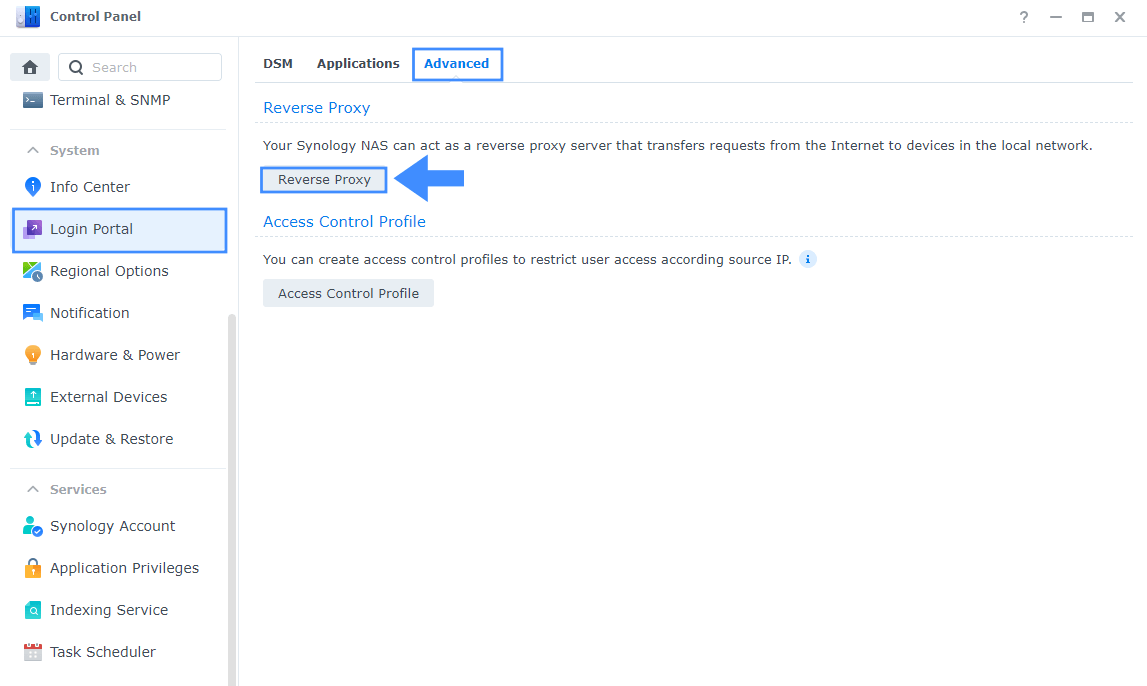
STEP 5
Now click the “Create” button. Follow the instructions in the image below.
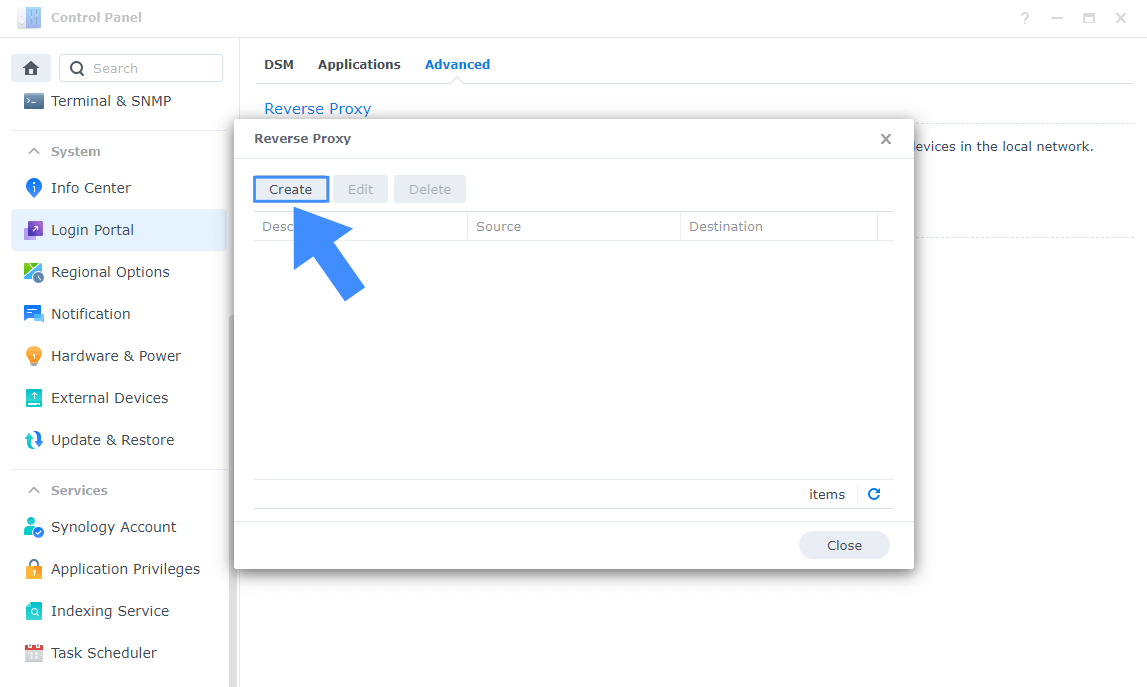
STEP 6
After you click the Create button, the window below will open. Follow the instructions in the image below.
On the General area, set the Reverse Proxy Name description: type in Mastodon. After that, add the following instructions:
Source:
Protocol: HTTPS
Hostname: mastodon.yourname.synology.me
Port: 443
Check Enable HSTS
Destination:
Protocol: HTTPS
Hostname: localhost
Port: 8562
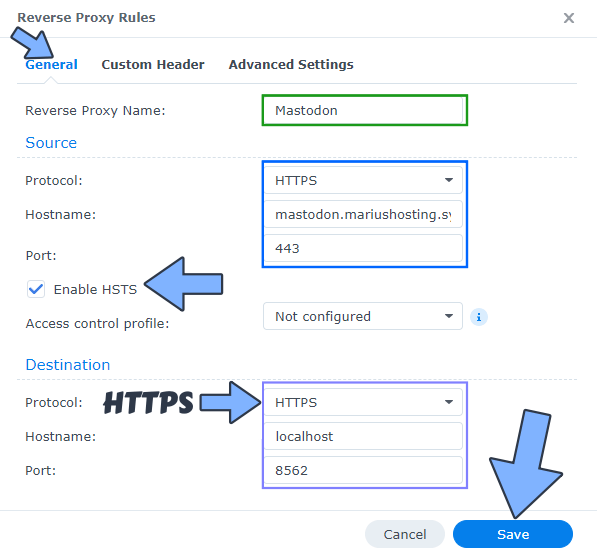
STEP 7
On the Reverse Proxy Rules click the Custom Header tab. Click Create and then, from the drop-down menu, click WebSocket. After you click on WebSocket, two Header Names and two Values will be automatically added. Click Save. Follow the instructions in the image below.

STEP 8
Go to Control Panel / Network / Connectivity tab/ Check Enable HTTP/2 then click Apply. Follow the instructions in the image below.
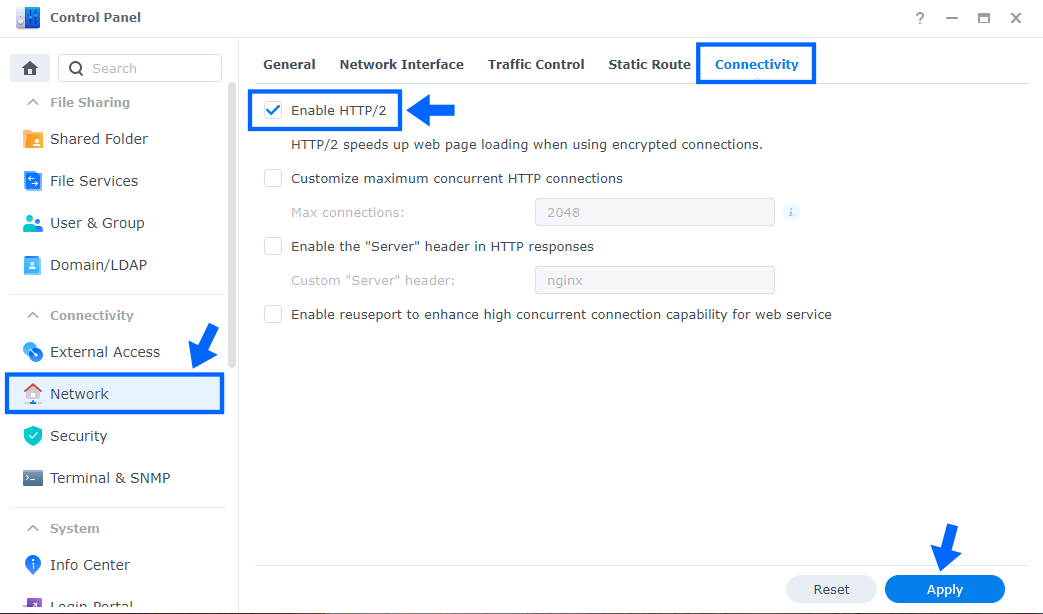
STEP 9
Go to Control Panel / Security / Advanced tab/ Check Enable HTTP Compression then click Apply. Follow the instructions in the image below.

STEP 10
Go to File Station and open the docker folder. Inside the docker folder, create one new folder and name it mastodon. Follow the instructions in the image below.
Note: Be careful to enter only lowercase, not uppercase letters.
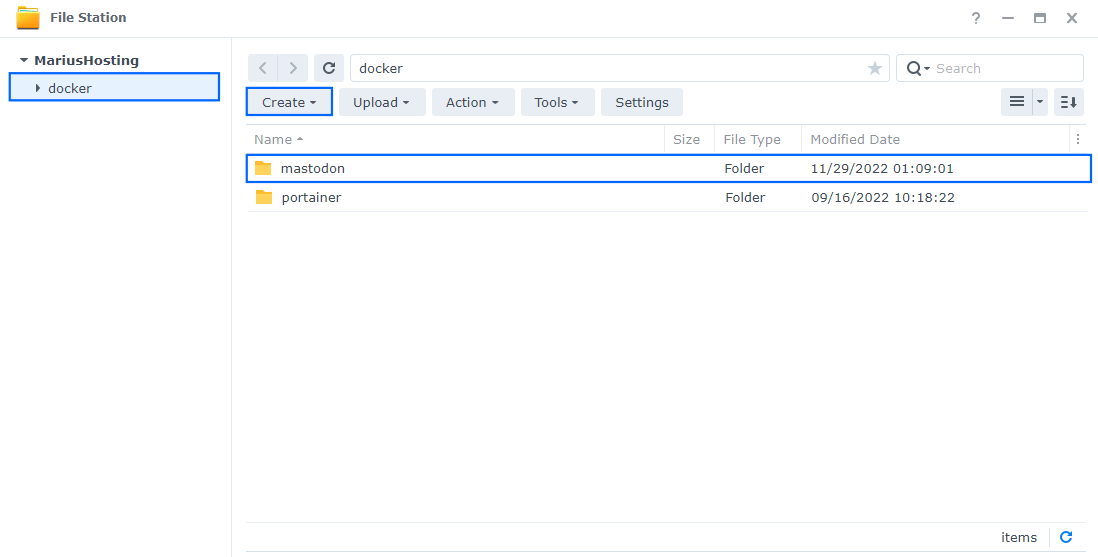
STEP 11
Now create three new folders inside the mastodon folder that you created at STEP 10 and name them config, db, redis. Follow the instructions in the image below.
Note: Be careful to enter only lowercase, not uppercase letters.
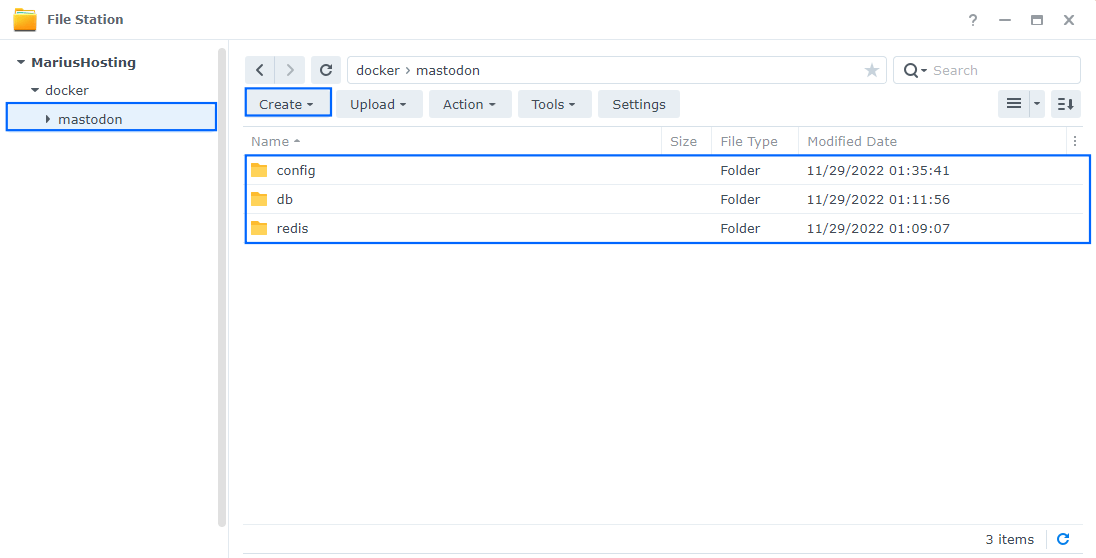
STEP 12
Log into Portainer using your username and password. On the left sidebar in Portainer, click on Stacks then + Add stack. Follow the instructions in the image below.

STEP 13
In the Name field type in mastodon. Follow the instructions in the image below.
services:
mastodon-redis:
image: redis
container_name: Mastodon-REDIS
hostname: mastodon-redis
security_opt:
- no-new-privileges:true
healthcheck:
test: ["CMD-SHELL", "redis-cli ping || exit 1"]
user: 1026:100
environment:
- TZ=Europe/Bucharest
volumes:
- /volume1/docker/mastodon/redis:/data:rw
restart: on-failure:5
mastodon-db:
image: postgres:17
container_name: Mastodon-DB
hostname: mastodon-db
security_opt:
- no-new-privileges:true
healthcheck:
test: ["CMD", "pg_isready", "-q", "-d", "mastodon", "-U", "mastodonuser"]
timeout: 45s
interval: 10s
retries: 10
volumes:
- /volume1/docker/mastodon/db:/var/lib/postgresql/data:rw
environment:
POSTGRES_DB: mastodon
POSTGRES_USER: mastodonuser
POSTGRES_PASSWORD: mastodonpw
restart: on-failure:5
mastodon:
image: lscr.io/linuxserver/mastodon:latest
container_name: Mastodon
hostname: mastodon
security_opt:
- no-new-privileges:true
environment:
- PUID=1026
- PGID=100
- TZ=Europe/Bucharest
- DEFAULT_LOCALE=en
- LOCAL_DOMAIN=mastodon.yourname.synology.me
- WEB_DOMAIN=mastodon.yourname.synology.me
- REDIS_HOST=mastodon-redis
- REDIS_PORT=6379
- DB_HOST=mastodon-db
- DB_USER=mastodonuser
- DB_NAME=mastodon
- DB_PASS=mastodonpw
- DB_PORT=5432
- ES_ENABLED=false
- ES_HOST=es
- ES_PORT=9200
- ES_USER=elastic
- ES_PASS=elastic
- SECRET_KEY_BASE=PIWLVVi14fqae5Ds8JqEGb3jGv3zVWJOoyxo6B2346vA00S3lzSL0cf3J0yxcB5pmu05qUHLQwIG8m8M97w56qvflufm7qdlRWoZoQ7sQjMDypdhRC54FcGD3rlSsBk4
- OTP_SECRET=wjZtoiw3udx1V586bVkGCkg1MrZ0UuRBSKVj8ghsrF4eGSCPLMhHw234lGRwkTAMUKy5TRZbUXgPqK5POkvCVof8lse7KJGVPgWHdkwrvyzhUTPp8b1vvBMABVQ76rCM
- ACTIVE_RECORD_ENCRYPTION_PRIMARY_KEY=6egLIdkH0vE5UXIwyZeU1qSL6tXwhd4j
- ACTIVE_RECORD_ENCRYPTION_DETERMINISTIC_KEY=bMQ59AJmJRCogwsgeFuqt8BXqwAf1Yt8
- ACTIVE_RECORD_ENCRYPTION_KEY_DERIVATION_SALT=ZpawFWM4ArOqRZbRtkYXeIqIKWLlsYZX
- S3_ENABLED=false
volumes:
- /volume1/docker/mastodon/config:/config:rw
ports:
- 8562:443
restart: on-failure:5
depends_on:
mastodon-redis:
condition: service_healthy
mastodon-db:
condition: service_started
Note: Before you paste the code above in the Web editor area below, change the value numbers for user with your own UID and GID values. (Follow my step by step guide on how to do this.) 1026 is my personal UID value and 100 is my personal GID value. You have to type in your own values.
Note: Before you paste the code above in the Web editor area below, change the value for TZ. (Select your current Time Zone from this list.)
Note: Before you paste the code above in the Web editor area below, change the value numbers for PUID and PGID with your own values. (Follow my step by step guide on how to do this.) 1026 is my personal PUID value and 100 is my personal PGID value. You have to type in your own values.
Note: Before you paste the code above in the Web editor area below, change the value for LOCAL_DOMAIN and type in your own synology.me DDNS that you have previously created at STEP 6, without https:// at the beginning.
Note: Before you paste the code above in the Web editor area below, change the value for WEB_DOMAIN and type in your own synology.me DDNS that you have previously created at STEP 6, without https:// at the beginning.
Note: Before you paste the code above in the Web editor area below, change the value for SECRET_KEY_BASE. (Generate your own 128 length SECRET_KEY_BASE.)
Note: Before you paste the code above in the Web editor area below, change the value for OTP_SECRET. (Generate your own 128 length OTP_SECRET.)
Note: Before you paste the code above in the Web editor area below, change the value for ACTIVE_RECORD_ENCRYPTION_PRIMARY_KEY. (Generate your own 32 length ACTIVE_RECORD_ENCRYPTION_PRIMARY_KEY.)
Note: Before you paste the code above in the Web editor area below, change the value for ACTIVE_RECORD_ENCRYPTION_DETERMINISTIC_KEY. (Generate your own 32 length ACTIVE_RECORD_ENCRYPTION_DETERMINISTIC_KEY.)
Note: Before you paste the code above in the Web editor area below, change the value for ACTIVE_RECORD_ENCRYPTION_KEY_DERIVATION_SALT. (Generate your own 32 length ACTIVE_RECORD_ENCRYPTION_KEY_DERIVATION_SALT.)
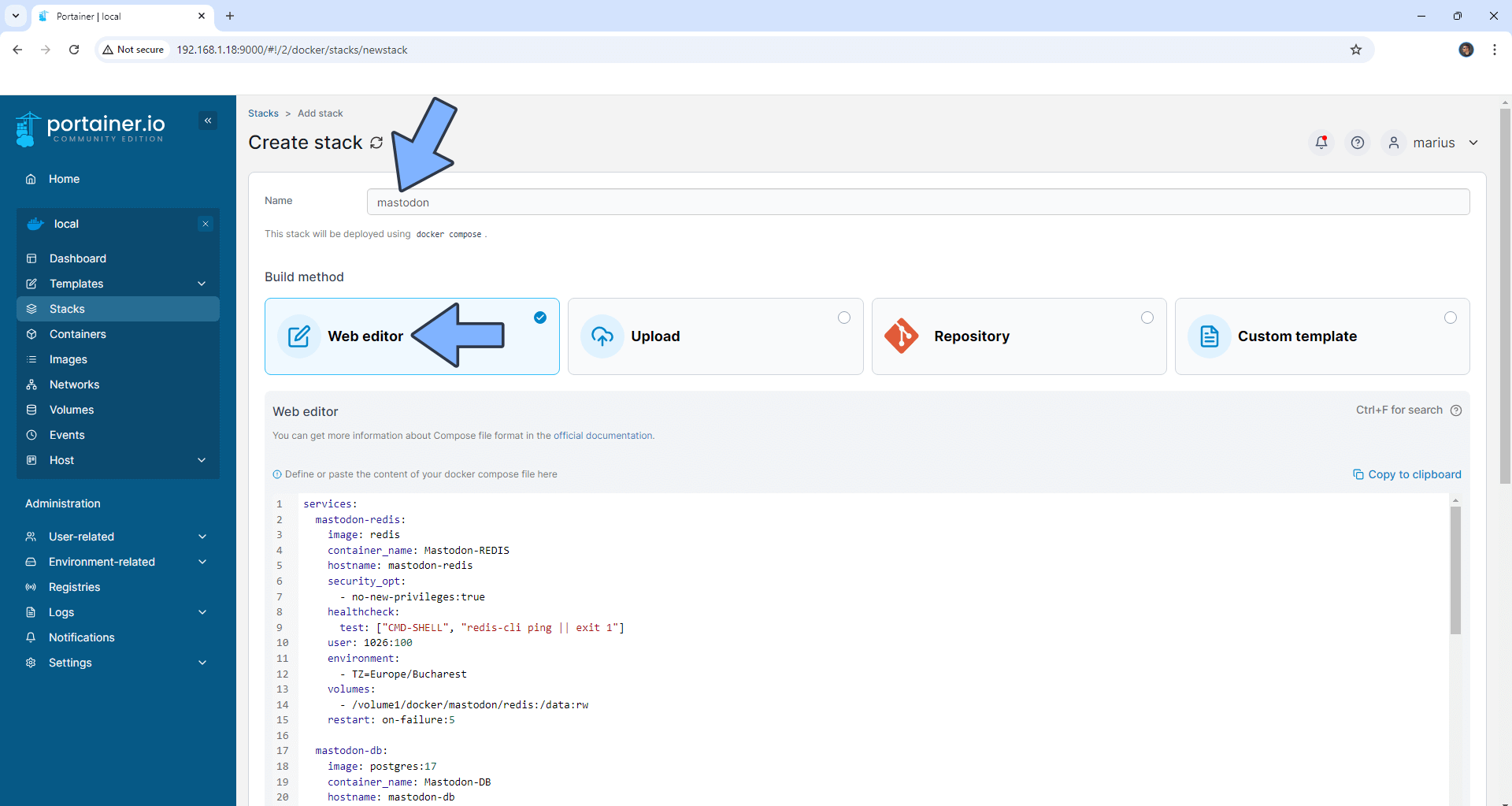
STEP 14
Scroll down on the page until you see a button named Deploy the stack. Click on it. Follow the instructions in the image below. The installation process can take up to a few minutes. It will depend on your Internet speed connection.
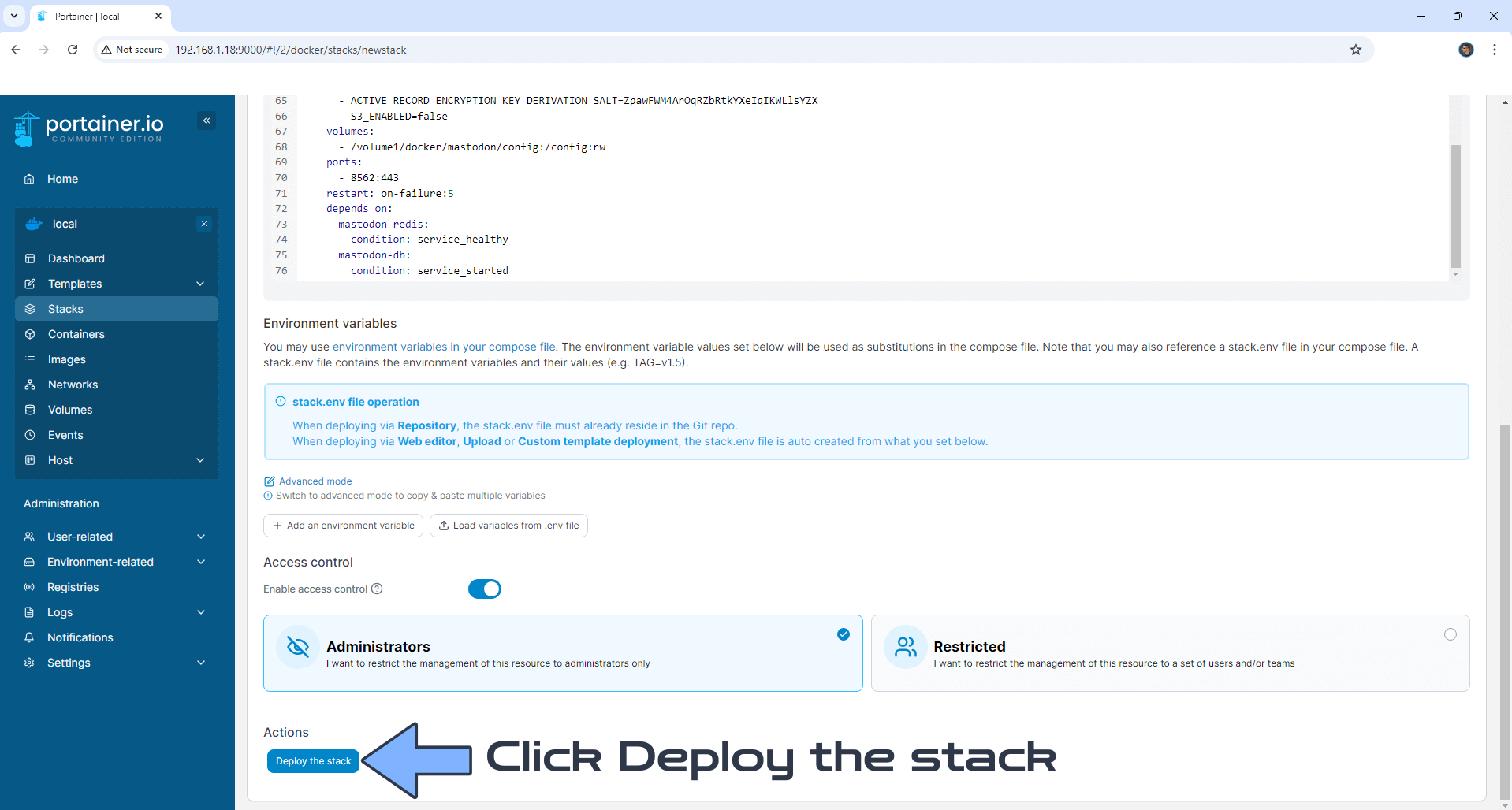
STEP 15
If everything goes right, you will see the following message at the top right of your screen: “Success Stack successfully deployed“.

STEP 16
On the left sidebar in Portainer, click Containers. Identify your Mastodon instance, then click on the little terminal icon. Follow the instructions in the image below.
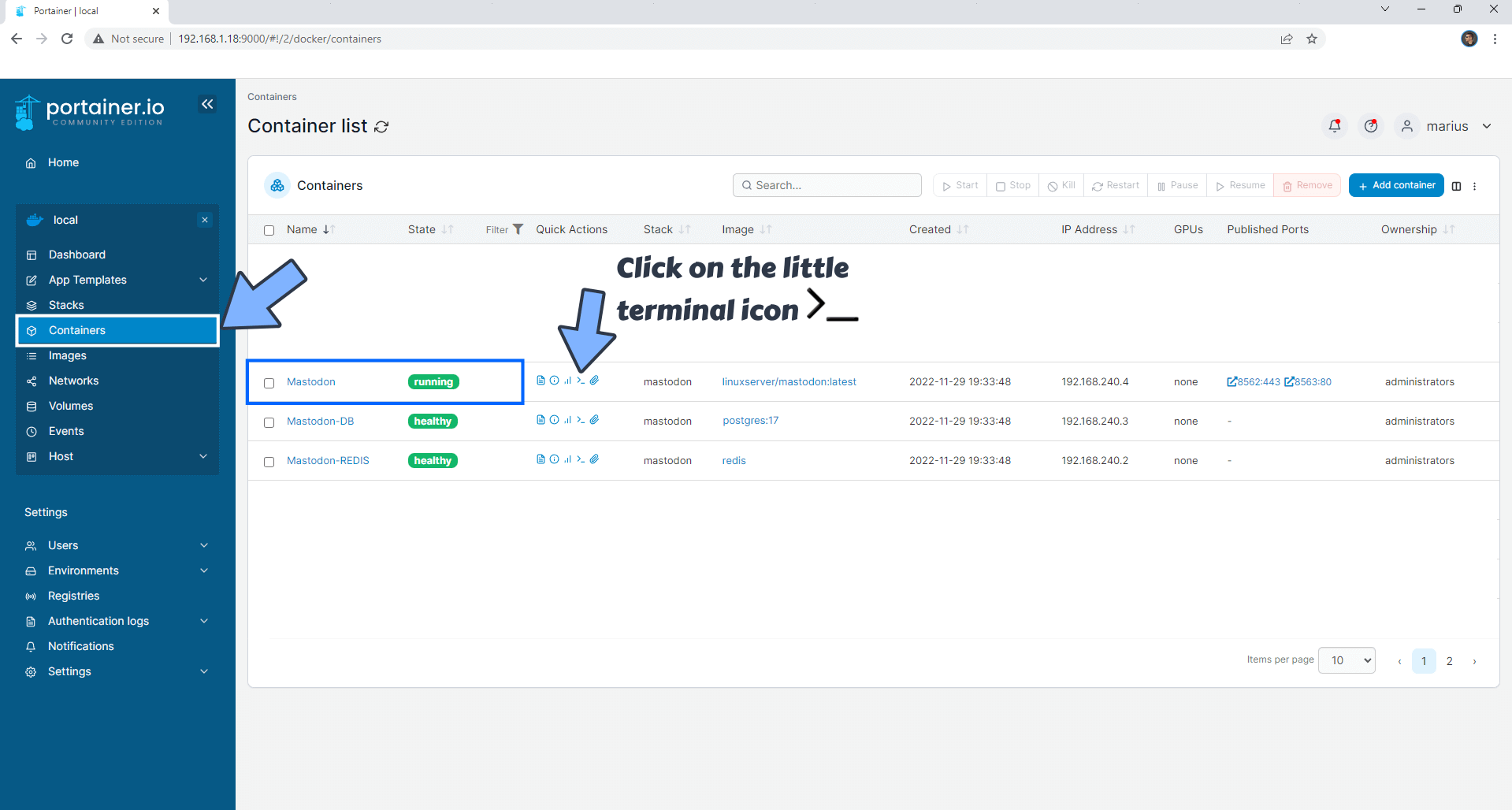
STEP 17
After you click on the little terminal icon at STEP 16, a new page will open. Click Connect. Follow the instructions in the image below.
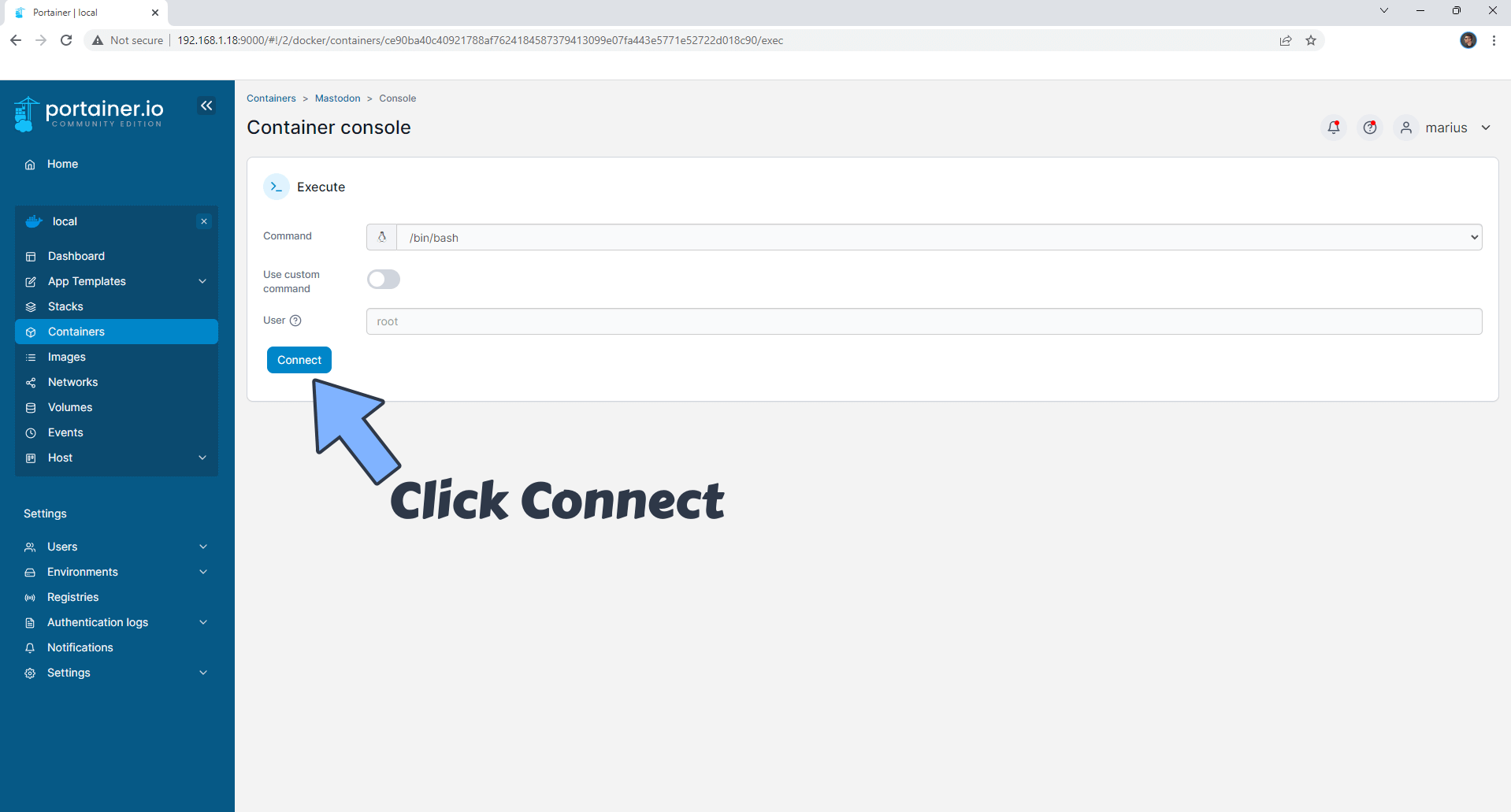
STEP 18
After you click Connect at STEP 17, a Console will open. Copy Paste the code below and follow the instructions in the image.
tootctl accounts create marius --email yourownemail --confirmed --role Owner
Note: Before you paste the code above in the Console area below, change marius with your own name.
Note: Before you paste the code above in the Console area below, change yourownemail text with your email.
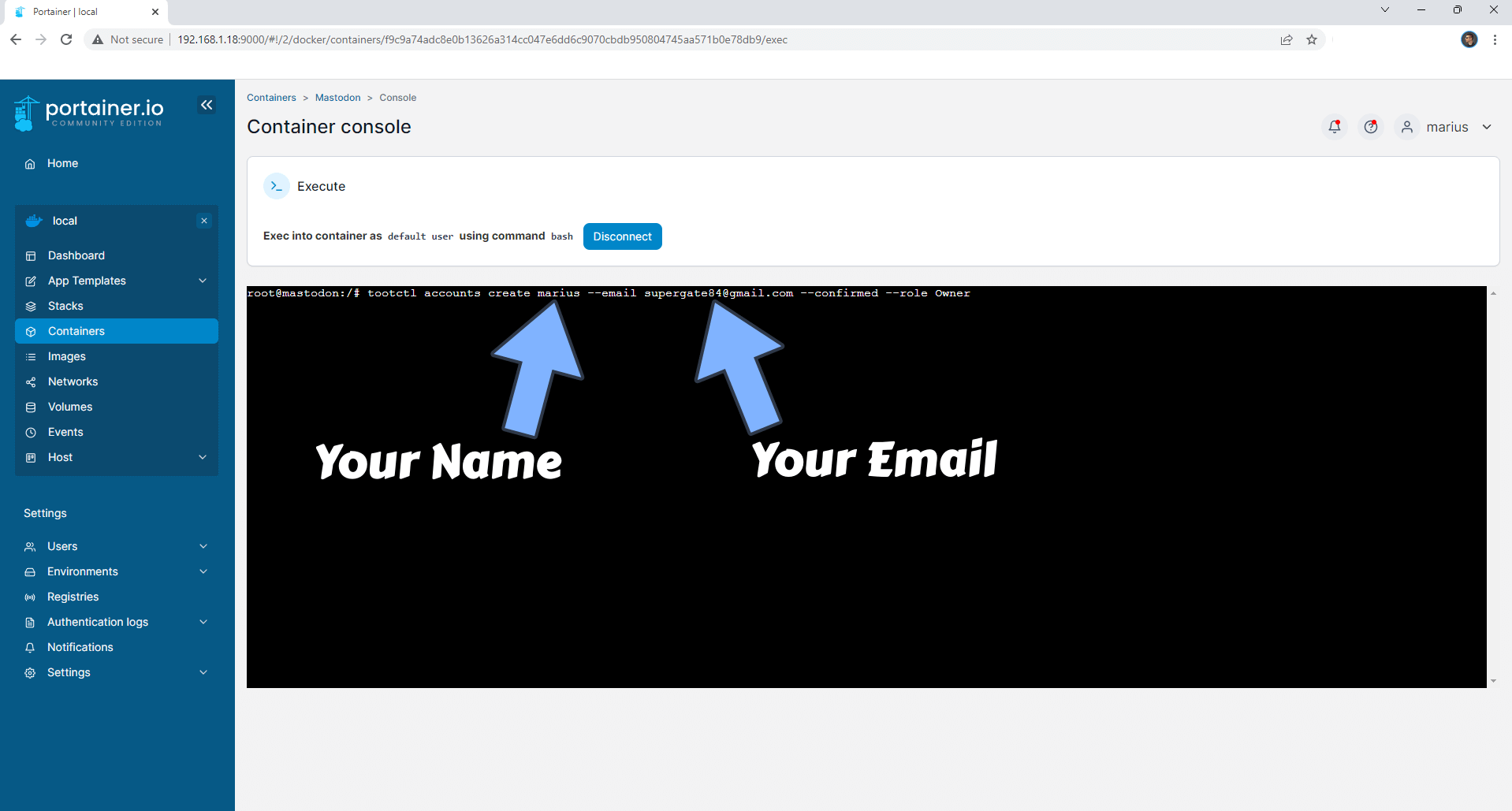
STEP 19
Once the code is inserted, confirm by pressing Enter on your keyboard to start the process of password creation. After some seconds, you will get a new password for the user you have previously created at STEP 18. Copy the password and save it in a safe place – you will need it later at STEP 23.
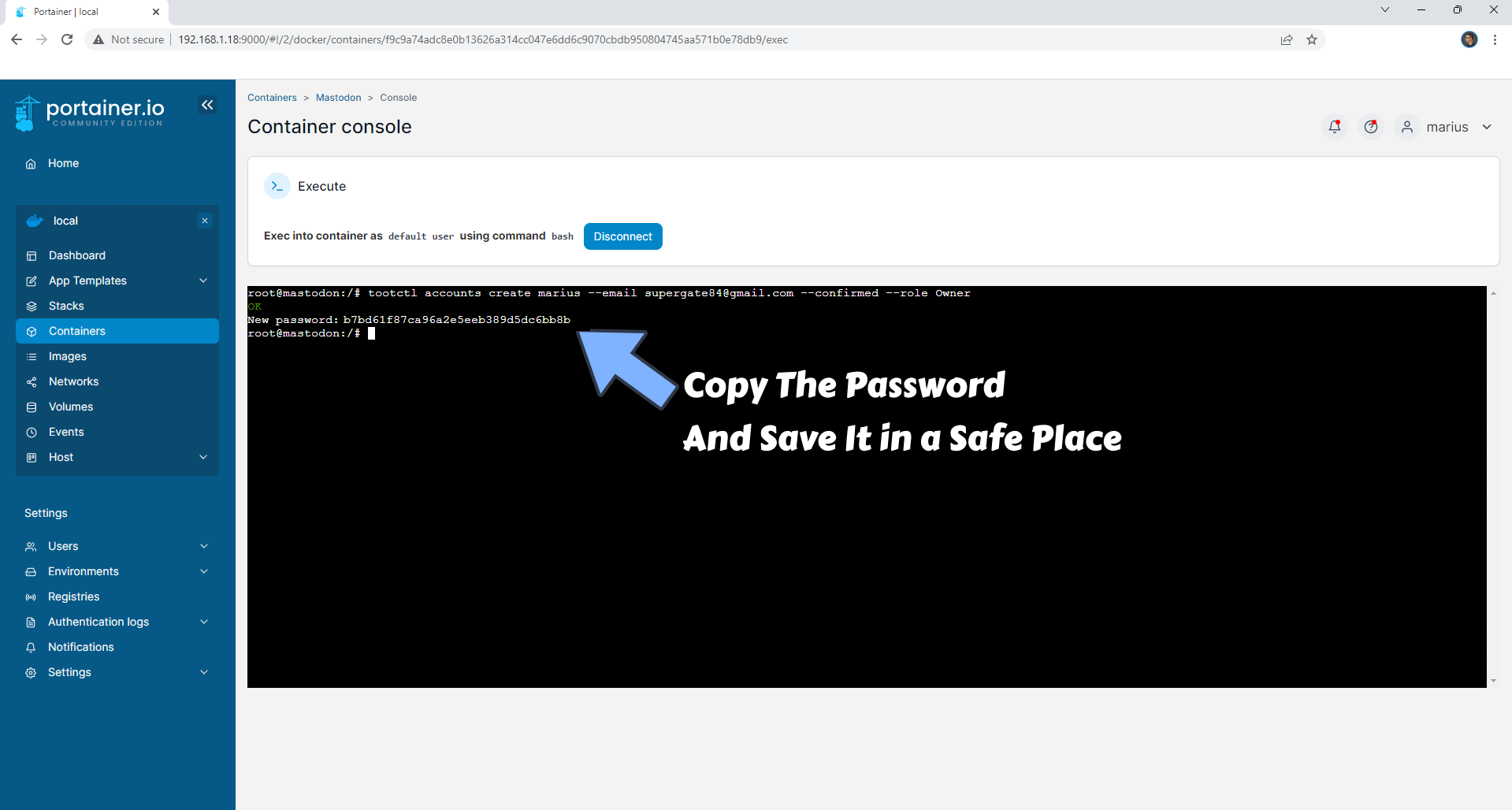
STEP 20
After your new password is created, copy paste the code below and follow the instructions in the image.
tootctl accounts approve mariusNote: Before you paste the code above in the Console area below, change marius with your own name that should be the same as the name that you have previously created at STEP 18.
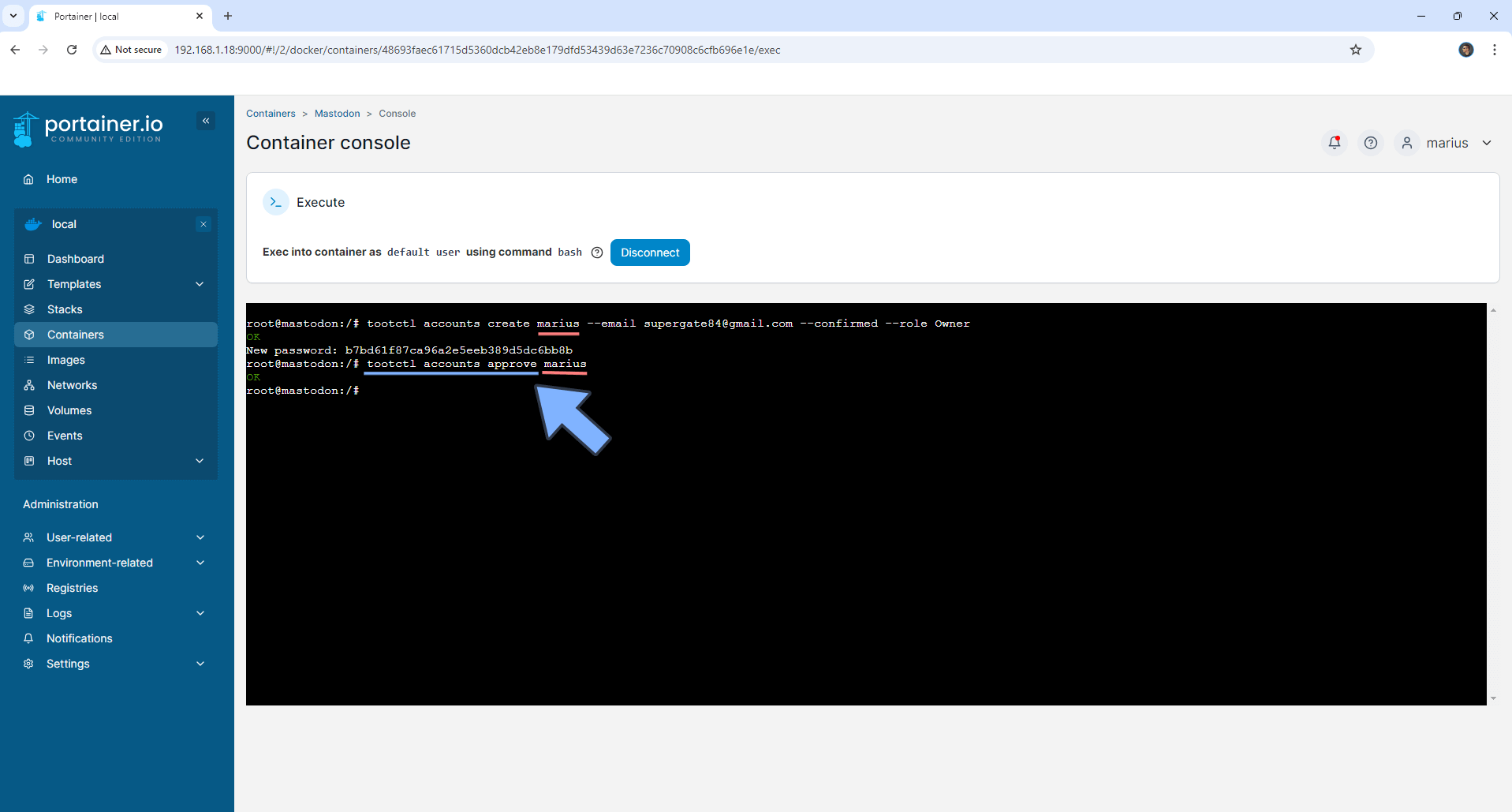
STEP 21
🟢Please Support My work by Making a Donation. Almost 99,9% of the people that install something using my guides forget to support my work, or just ignore STEP 1. I’ve been very honest about this aspect of my work since the beginning: I don’t run any ADS, I don’t require subscriptions, paid or otherwise, I don’t collect IPs, emails, and I don’t have any referral links from Amazon or other merchants. I also don’t have any POP-UPs or COOKIES. I have repeatedly been told over the years how much I have contributed to the community. It’s something I love doing and have been honest about my passion since the beginning. But I also Need The Community to Support me Back to be able to continue doing this work.
STEP 22
Now open your browser and type in your HTTPS/SSL certificate like this https://mastodon.yourname.synology.me that you have previously created at STEP 6. In my case it’s https://mastodon.mariushosting.synology.me If everything goes right, you will see the main Mastodon page. Click Login. Follow the instructions in the image below.
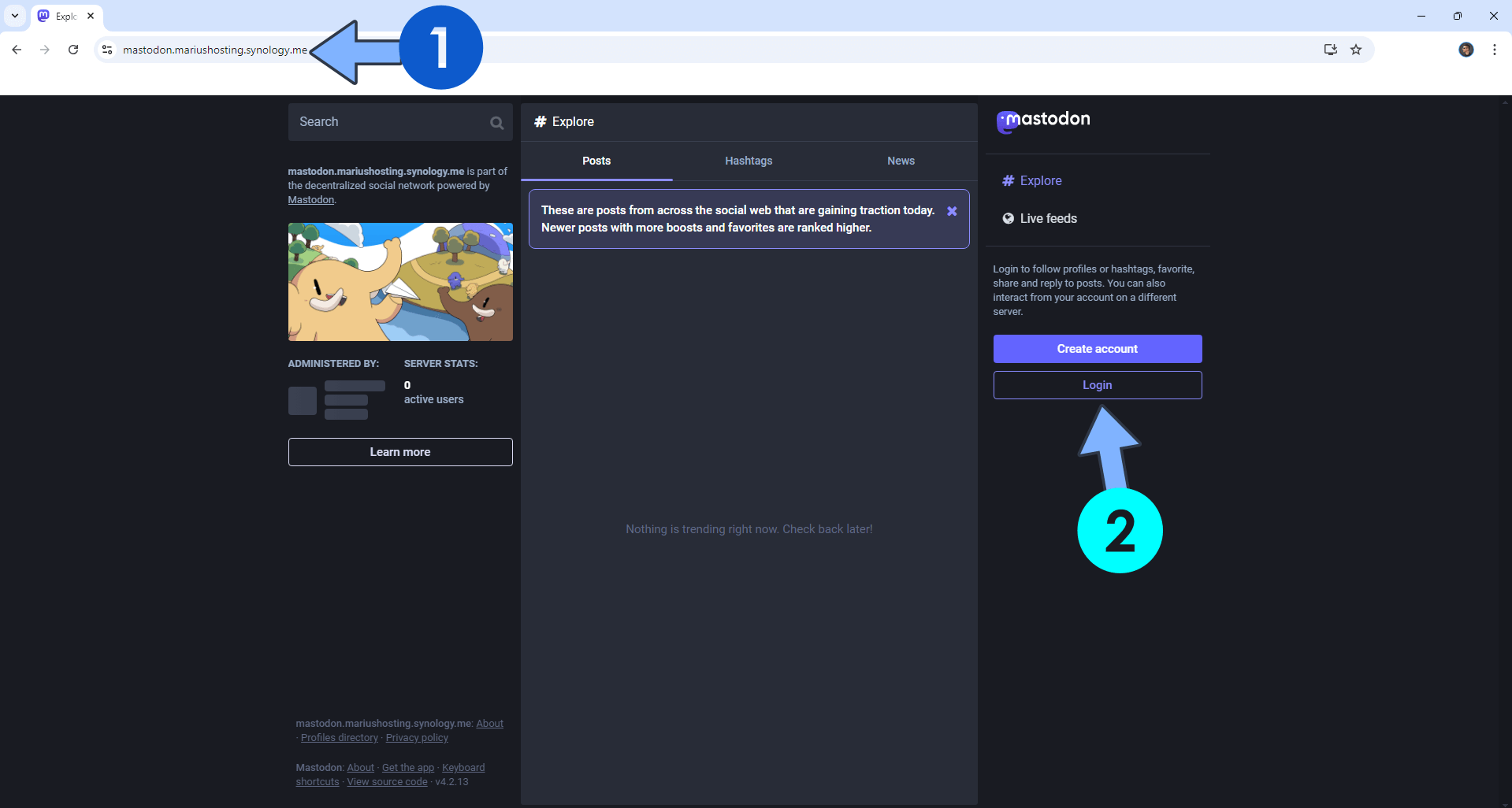
STEP 23
On the E-mail address field type in the email you have chosen at STEP 18. On the Password field type in the password you have previously generated automatically at STEP 19. Click LOG IN. Follow the instructions in the image below.
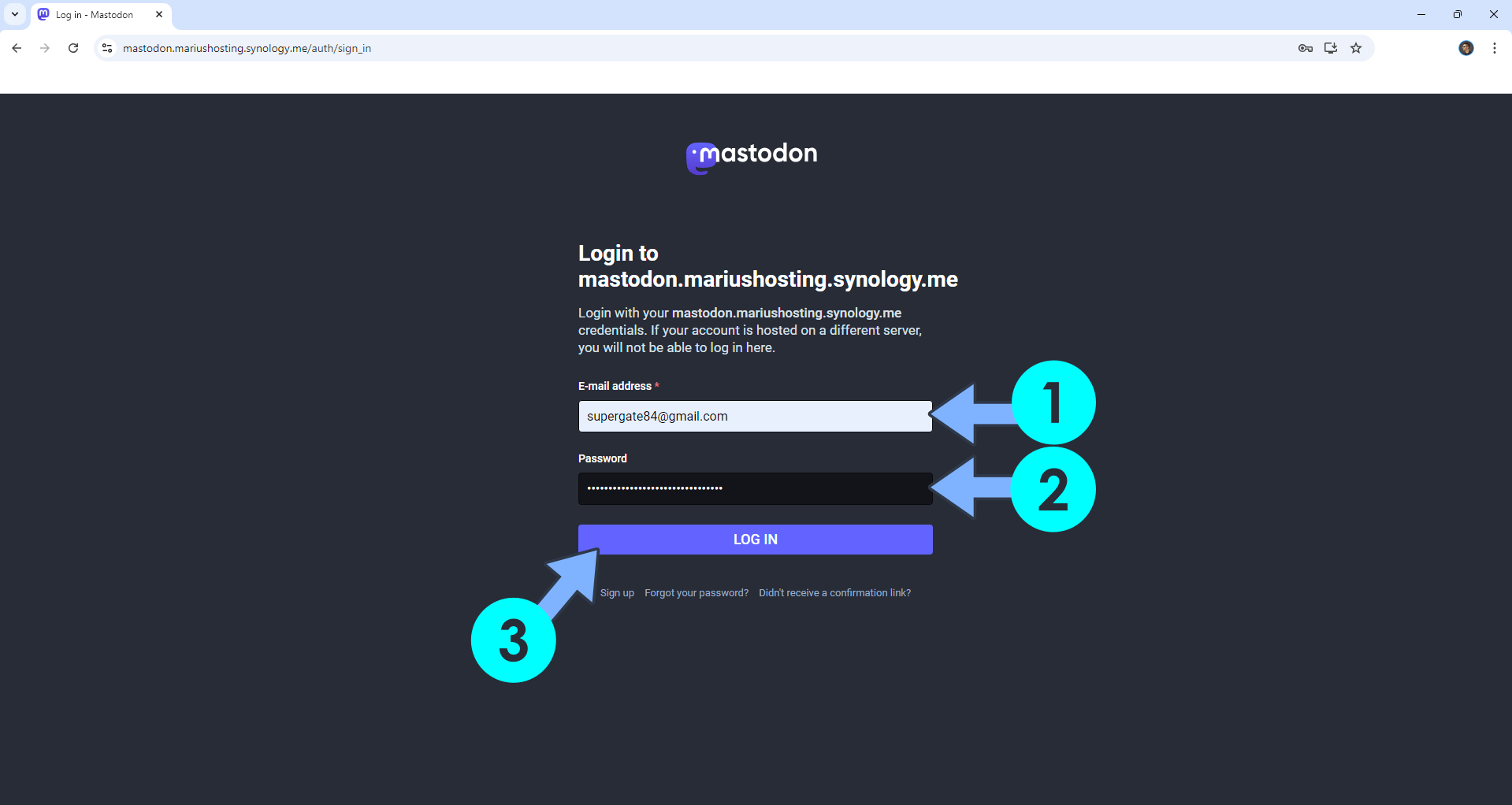
STEP 24
Personalize your own profile, then click Preferences to access your Administration area. Follow the instructions in the image below.
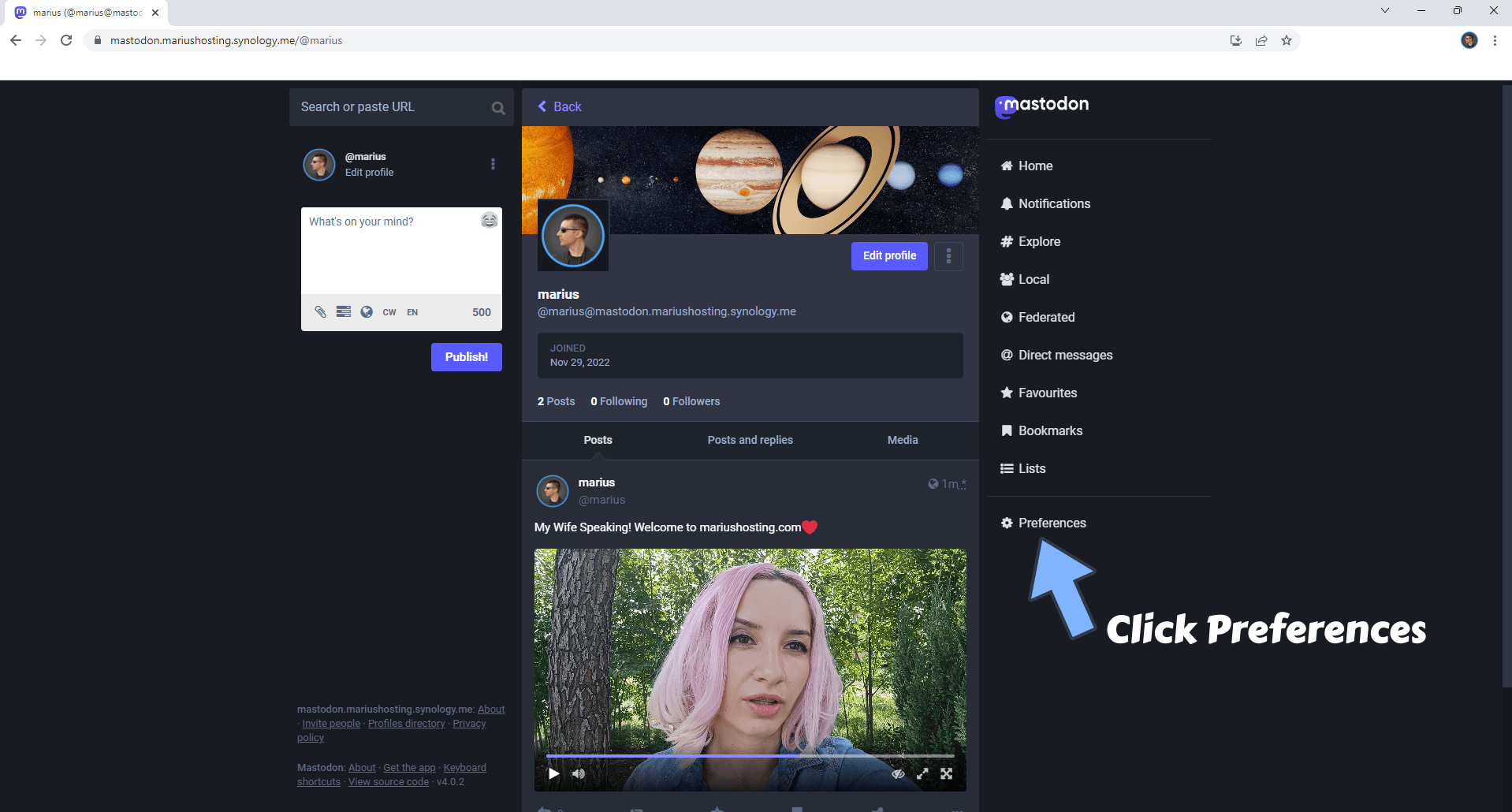
STEP 25
On the left sidebar click Administration. Follow the instructions in the image below.
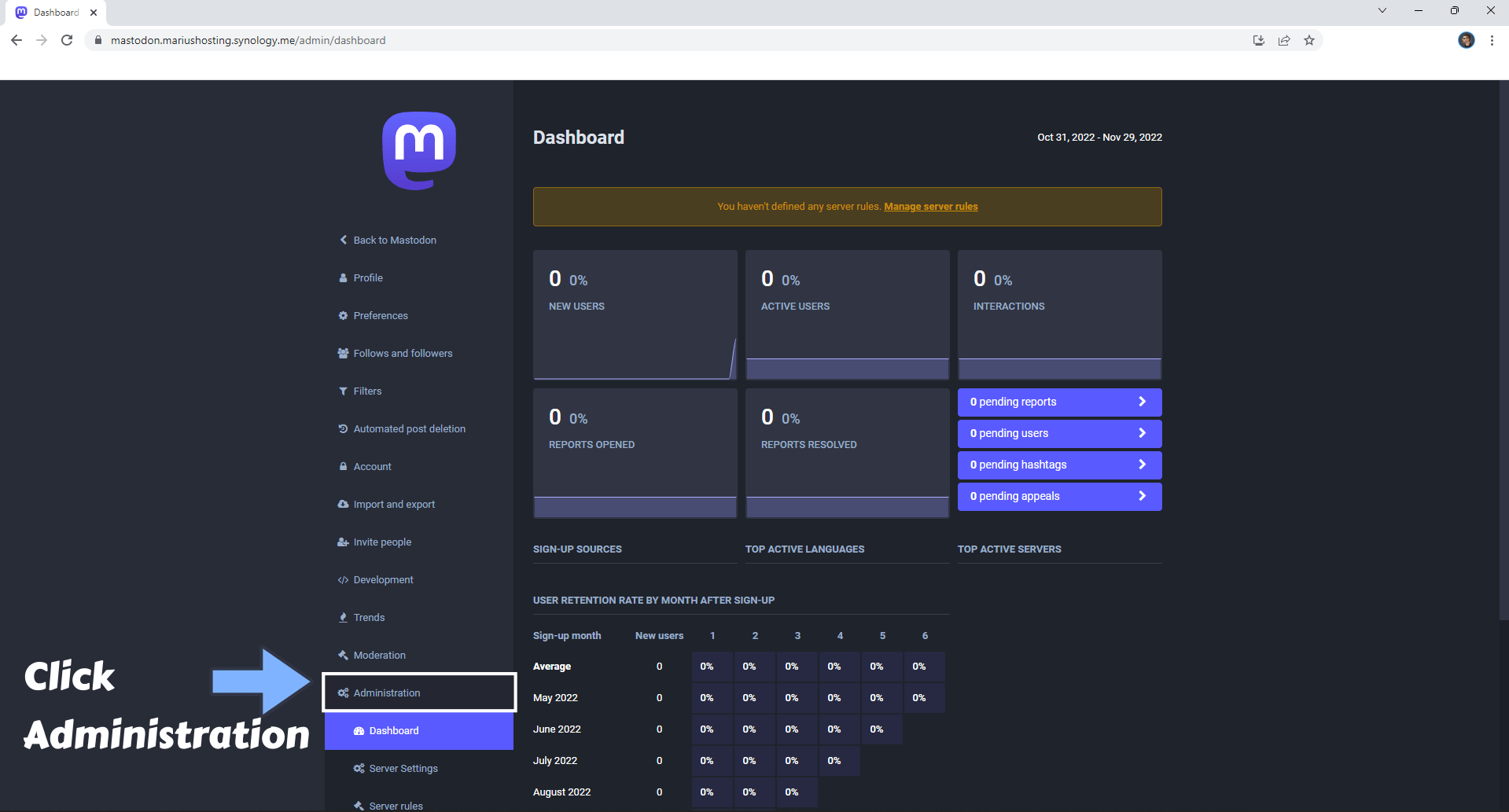
STEP 26
Under Administration, click Server Settings to personalize your Mastodon Server. Follow the instructions in the image below.
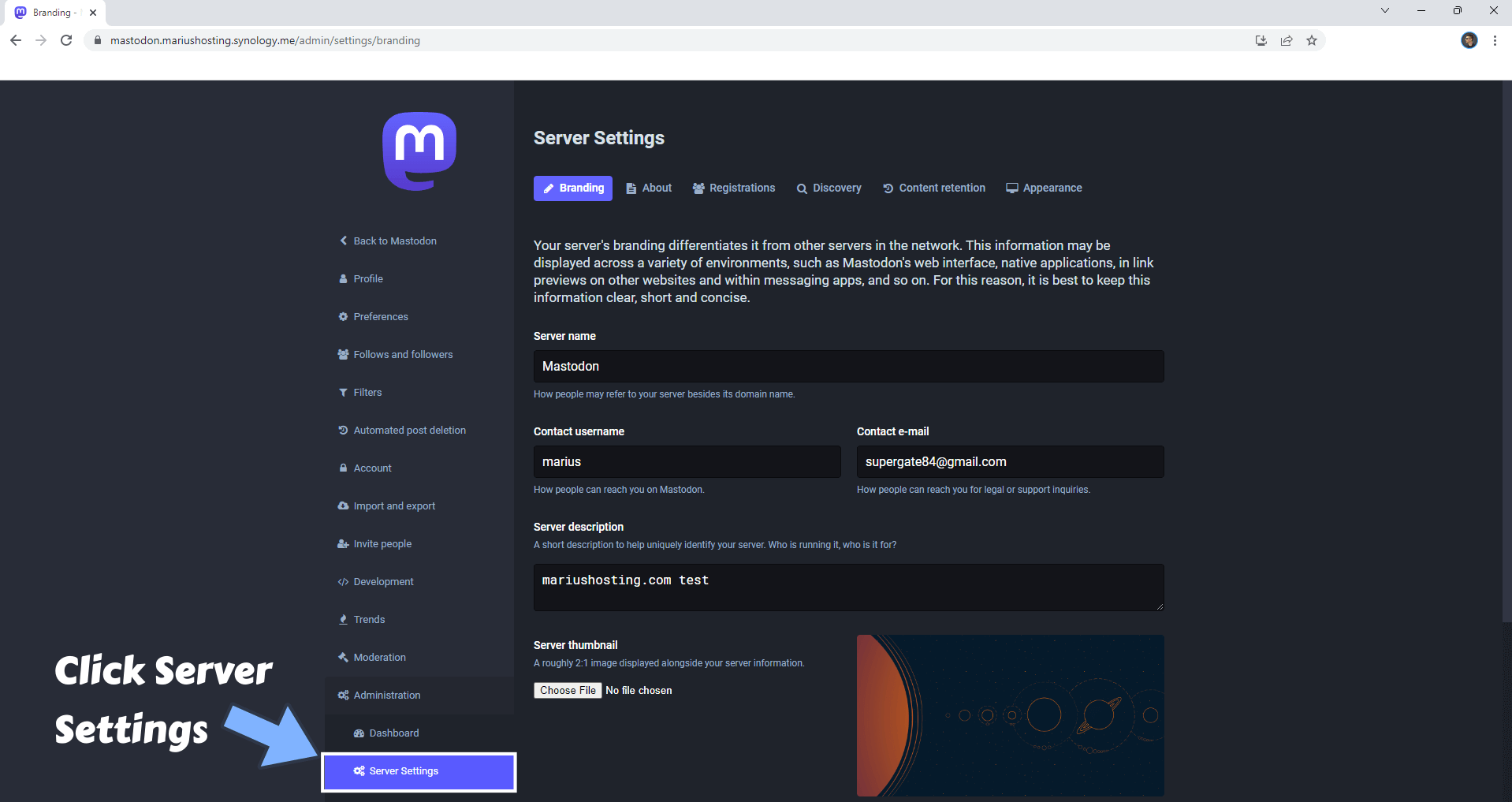
STEP 27
If a new user will subscribe to your Server, you will find it under Moderation in the Accounts area. Click Accounts. Click on the new user profile. Follow the instructions in the image below.
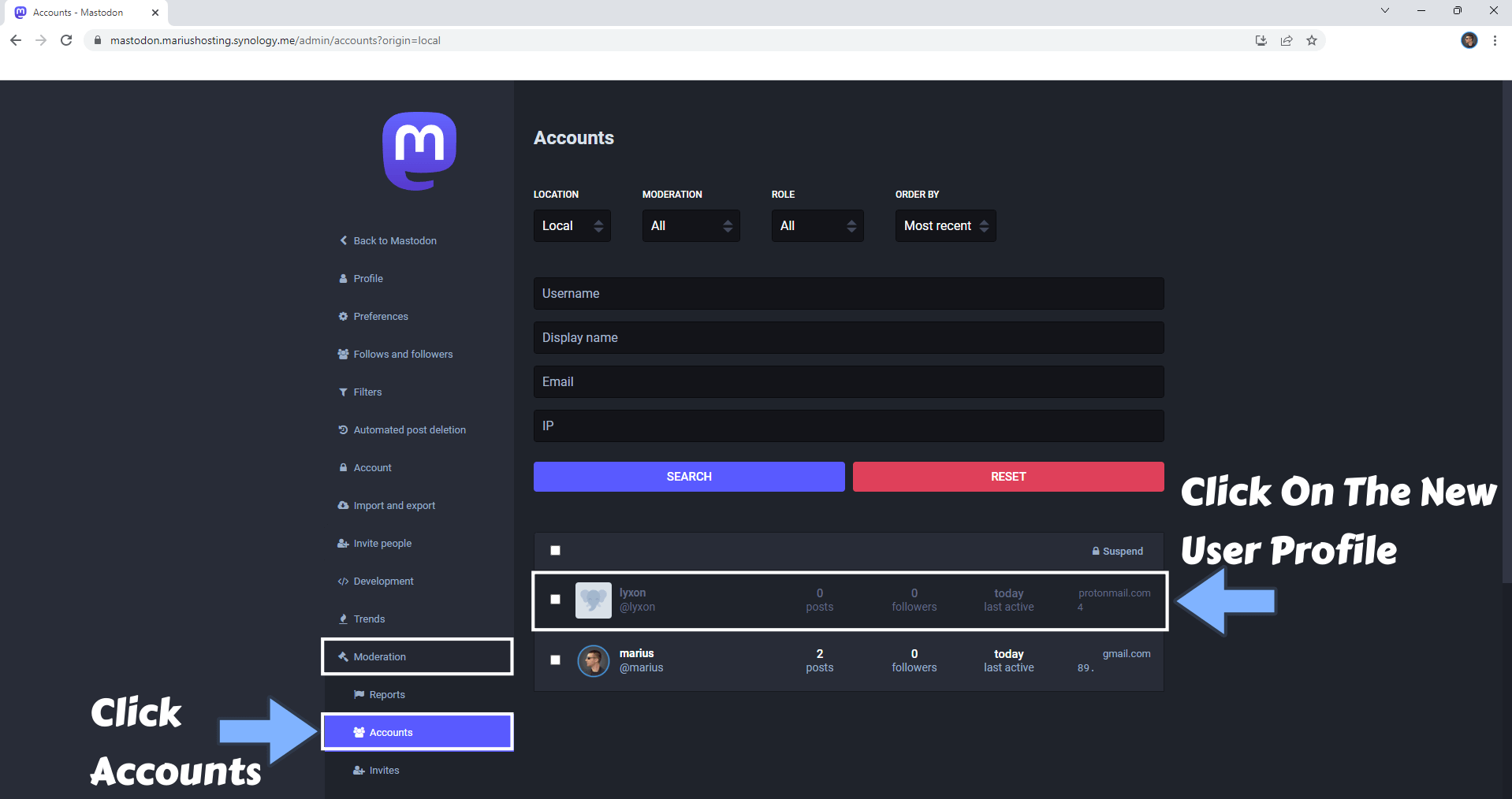
STEP 28
Click Confirm to confirm the new user. Once the new user is approved, they can start using your Mastodon server. Follow the instructions in the image below.
📝Note: The Owners, Administrators, and Moderators can approve new members.
📝Note: Just to clarify: every user that will register a new account on your server will need manual confirmation to start using their profile on your Mastodon server. No Email will be sent to the new user when they register for the first time. I decided not to include the SMTP email server (in the docker compose) for automatic confirmation of new users so as not to overload the email server. For this reason, I thought it is only fair that all new users be manually approved by the owner, administrators or moderators so that you have complete control of the users coming to your private Mastodon server. If you want the new users to receive an automatic registration confirmation email, contact me.
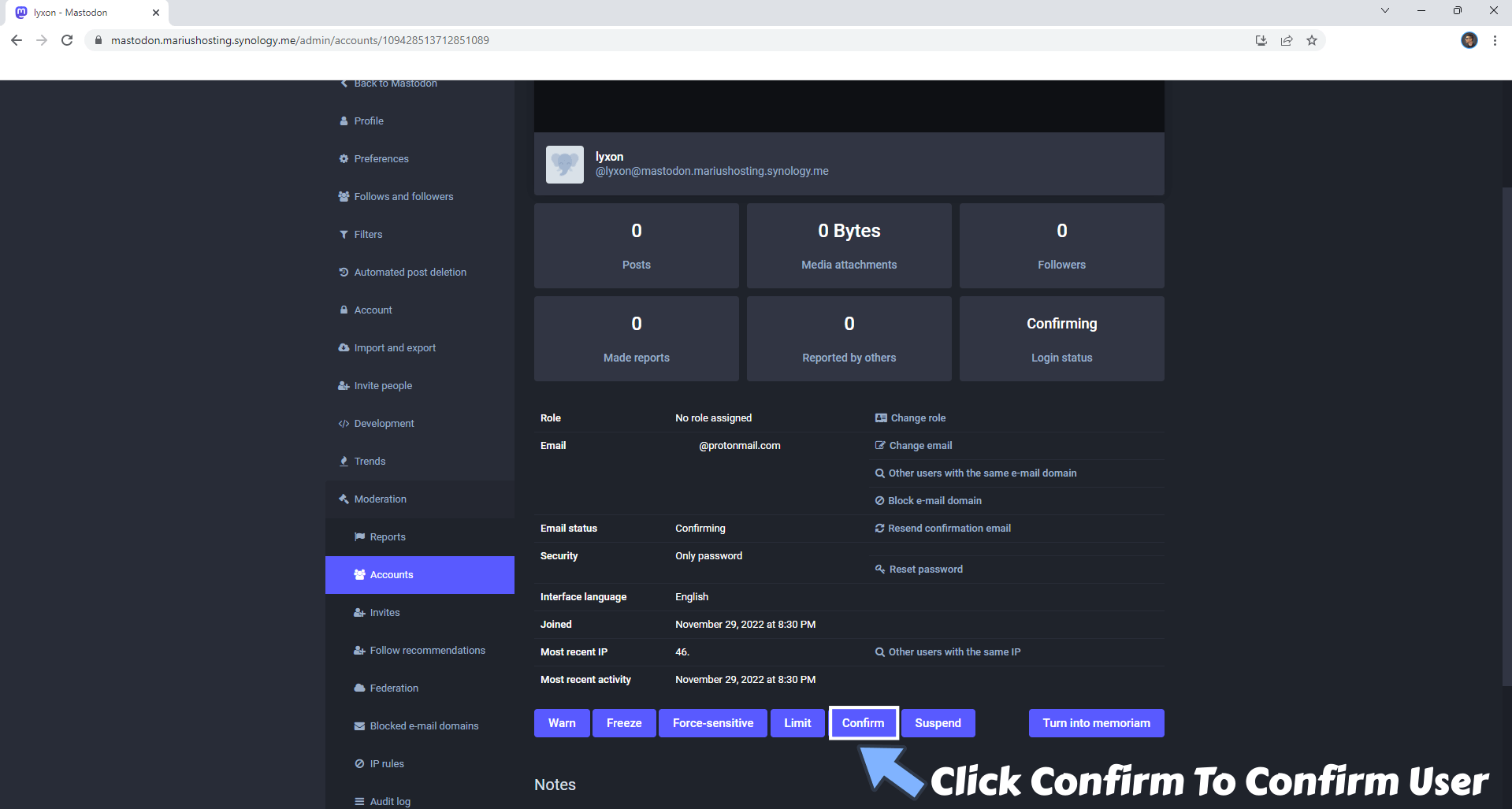
Enjoy your Mastodon Server!
If you encounter issues by using this container, make sure to check out the Common Docker issues article.
Note: Find out how to update the Mastodon container with the latest image.
Note: How to Back Up Docker Containers on your Synology NAS.
Note: Can I run Docker on my Synology NAS? See the supported models.
Note: How to Free Disk Space on Your NAS if You Run Docker.
Note: How to Schedule Start & Stop For Docker Containers.
Note: How to Activate Email Notifications.
Note: How to Add Access Control Profile on Your NAS.
Note: How to Change Docker Containers Restart Policy.
Note: How to Use Docker Containers With VPN.
Note: Convert Docker Run Into Docker Compose.
Note: How to Clean Docker.
Note: How to Clean Docker Automatically.
Note: Best Practices When Using Docker and DDNS.
Note: Some Docker Containers Need WebSocket.
Note: Find out the Best NAS Models For Docker.
Note: Activate Gmail SMTP For Docker Containers.
This post was updated on Friday / July 11th, 2025 at 9:34 PM
